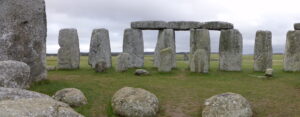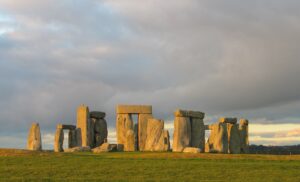
There is an interesting paper out by Tim Darvill in which he discusses the architecture of Stonehenge and the way in which it is designed to manipulate the experience of those using the monument. In particular, he considers the use of a square element set within an outer circle. Darvill is not negating the way in which Stonehenge developed out of a series of earlier settings, but his argument focuses on the manifestation that left the remains we see today and on the relationship between the bluestone elements of the monument and those comprising the sarsen stones. His interpretation of all this is very personal and some of it has been rehearsed by him before, not least the possibility that the incorporation of the bluestones may have brought special healing properties to Stonehenge. I can’t comment on that, but his paper did put me in mind of my own thoughts when I visited Stonehenge recently and had the privilege of entering into the heart of the monument.
What shocked me as I walked beneath the sarsen trilithon that is traditionally seen as the entrance to the centre (on the side by the Avenue) was the way in which the bluestone circle blocked me from entering further into the heart of the site. In order to progress I had to make a decision: to turn left or turn right. That, in itself is not unusual. What surprised me is that this is precisely the way in which one experiences the monumental structure known (by us) as Structure 8 at Barnhouse in Orkney. At Barnhouse you enter Structure 8 through a narrow break on the eastern side of the outer wall (nb: popular images often show an entrance at the north opposite the entrance to the inner circle, but the main break through the outer wall is to the east and that is the one that appears in Richards’ publication). Once inside, you are confronted by another wall, seemingly unbroken and running to both left and right. Eventually, by following this wall around, one reaches a more complex entrance passage running into the heart of the site. Structure 8, incidentally, incorporates the square-in-a-circle formation that Darville notes at Stonehenge (as Darville recognises). Curiously, this is precisely the symbol used as the World Heritage logo – though in that case the circle represents nature while the square represents human endeavour. It is a powerful motif.
I’ve no idea what this means. There are many, many questions left unanswered: was the inner structure at Barnhouse roofed? Was the outer passage roofed? How high were the walls? How, precisely, were the different elements of the structure at Stonehenge differentiated? What was it all for? What is interesting to me is the overt manipulation of the human experience. I’m fascinated by the way in which our surroundings can cause us to move in certain directions almost unconsciously. Of course, it may have been very overt in the Neolithic, perhaps there were big red warning markers telling people how to behave once inside. That does not really concern me. But I think we can see this sort of control manifest at a variety of other sites and I’m wondering if it is fundamental to this type of Neolithic public space.
Structure 10 at Ness of Brodgar is not completely excavated in plan, but it looks as if it may incorporate a similar entrance system (curiously, the plan suggests that the rounded element of the structure lay inside the square element here, though perhaps the outside wall of the whole site functioned as a rounded boundary). Even the architecture of the henge sites with their banks and ditches, stone circles and interior settings, as at the Stones of Stenness, could be seen as incorporating a series of concentric passages. We don’t know, can’t know, what it means, but to me it suggests that the design of these monuments incorporated some very specific, and perhaps symbolic, behavioural control and that this was repeated from one site to another. Those who visited Barnhouse would have known what was expected of them at Stonehenge.
As, of course, do we – as disciples of the heritage age we arrive at these sites prepared to display certain behaviour: we exhibit awe; we usually walk round in a certain way; we read the guidebooks; we take photographs; we look for the entrance booth to pay; we don’t leave graffiti…

You must be logged in to post a comment.